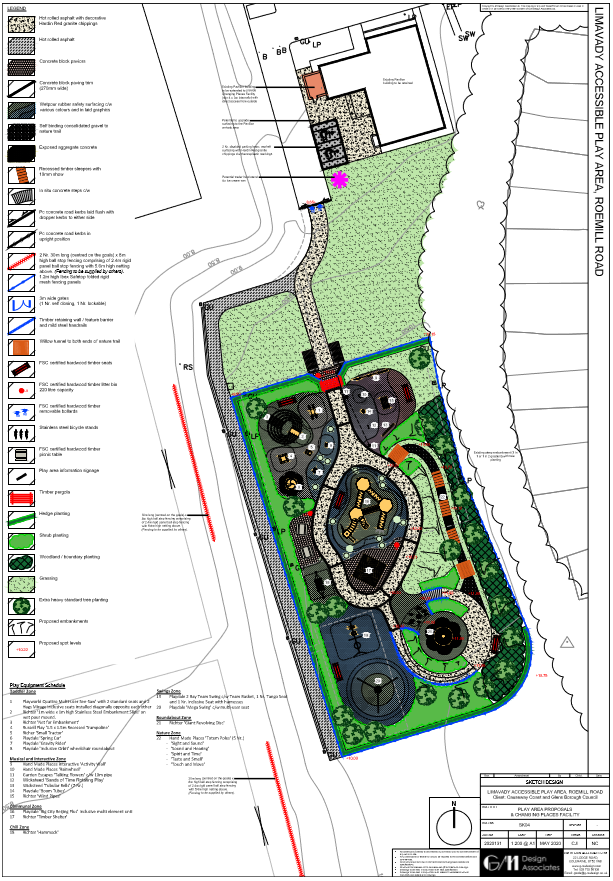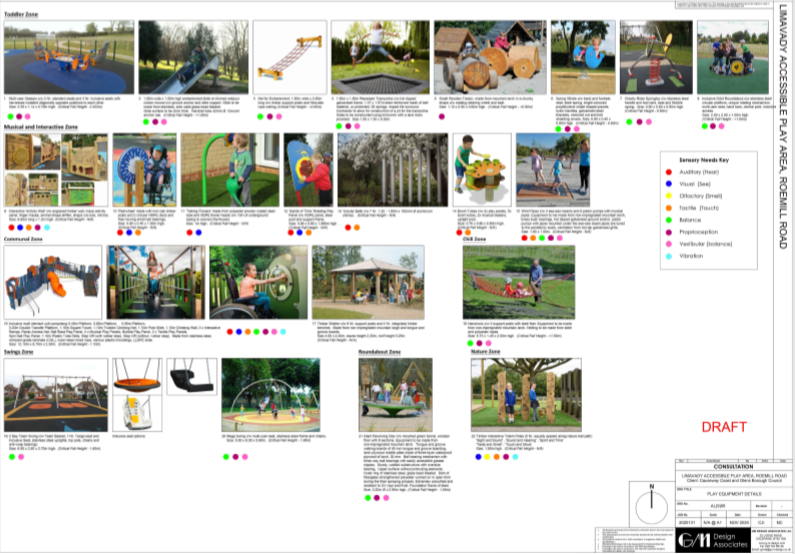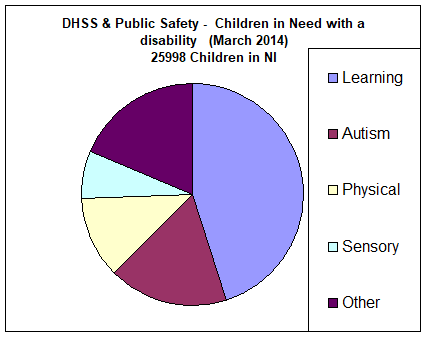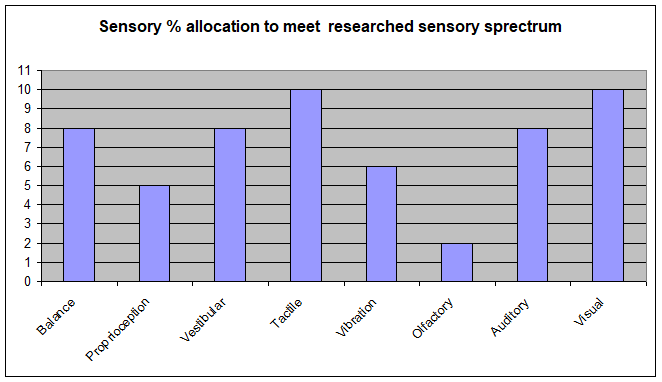Limavady Accessible Play Park
S75 Equality And Good Relations Screening Form
| General Information |
| Service/ Function ☐ |
Policy/ Procedure ☐ |
Project ☒ |
Strategy ☐ |
Plan ☐ |
Guidance ☐ |
| Is this an existing, revised or a new function, service, policy, procedure, project, strategy, plan or guidance? Existing ☐ Revised ☐ New ☒ |
| Operational Area | Sport and Wellbeing |
| Title | Limavady Accessible Play Park |
| Brief Summary In 2017 Council agreed to prioritise a list of 10 capital projects. The top ranking project was Limavady Accessible Play Park. In compliance with Stage 1 of the Council’s capital approval process the next stage was the development of an Outline Business Case (OBC). Concurrent with this capital planning process, Council commissioned Playboard NI to undertake a Play Strategy for the Borough. This work was completed in 2018 with the research and analysis informing the Needs & Demand Assessment for this project. The Play Investment Strategy has an associated action plan with a key recommendation being the development of an Accessible Play Park in Limavady at an indicative cost of £500k. The OBC has been developed on the basis of an extensive consultation process undertaken by Playboard NI. The consultation process set out to establish, at a local level, if need and demand existed through extensive consultation with young people, parent/carers and the wider public. Consultation has also involved potential partner organisations, including local schools. In October 2020 Members approved the Stage 1 OBC and the following recommendation: “It is recommended that the preferred option, Option 3 – New Accessible Play Park at Roe Mill Playing Fields (Comprehensive Specification), Changing Places and Parking is progressed to Stage 2, detailed design and full business case for a final investment decision to be taken by Council”. With an estimated capital cost of £542k, the concept design and indicative equipment schedule are provided for reference in Appendix 1. |
| What is it trying to achieve? (intended aims and outcomes) All children have the right to access appropriate play opportunities and a fundamental aspect of the play investment strategy will be working to ensure that that fixed play areas offer play opportunities for children of all abilities. Accessible and inclusive play means more than simply providing children and families with physical access to play areas and equipment. In order to be truly inclusive a play area must offer a wide range of high quality physical, creative and social play opportunities for children regardless of their needs and abilities. The benefits of accessible play areas are well established for children of all abilities:
|
| Who owns and who implements each element of the function, service, policy, procedure, project, strategy, plan or guidance? The SRO for the project is the Director of Leisure and Development and the Sponsor is the Head of Sport and Wellbeing. A proportionate governance structure has been put in place with Steering Group meetings on a monthly basis to oversee project development. Implementation of the project will involve support from internal stakeholders (Capital Delivery Team, Estates, Operations); and collaboration with external stakeholders (local schools, special interest groups and the general public). |
|
Other policies etc. which have a bearing on this function, service, policy, procedure, project, strategy, plan or guidance?
|
| Available Evidence Evidence to help inform the screening process may take many forms. Public authorities should ensure that their screening decision is informed by relevant data. What evidence/information (both qualitative and quantitative have you gathered to inform this function, service, policy, procedure, project, strategy, plan or guidance? Specify details for relevant Section 75 categories. |
It is proposed that all Section 75 categories will be considered via:
|
| Section 75 Category | Details of Evidence/Information
|
||||||||||||||||||||||||||||||||||||||||||||||||||||||||||||||||||||||||||||||||||||
| Religious Beliefs |
The 2011 Census outlined:
In terms of religion or religion brought up in the 2011 Census indicates that our resident’s religious beliefs are comparable to those in Northern Ireland in that there are 2 predominant groupings i.e. Roman Catholic and Protestant. However we also have a number of individuals (5.64%) who do not practice a specific religion or who do not wish to be grouped into a specific religion. In addition we have a small number of individuals who practice other religions. No issues regarding religious beliefs were raised during consultation with stakeholders who have various religious beliefs and multiple identities. The Roe Mill Road area is of perceived mixed community background and visitors to the park should feel welcome.The opening hours demonstrate that they are wide and varied to facilitate enjoyment by all 7 days a week to accommodate those of various religious and non-religious beliefs.) In conclusion, this project should not impact upon any religious group and will be a shared space where everyone should feel welcome and therefore have a neutral impact on this Section 75 group. |
||||||||||||||||||||||||||||||||||||||||||||||||||||||||||||||||||||||||||||||||||||
| Political Opinion |
The Northern Ireland Life and Times Survey (2018) provides the following information on the political parties people in Northern Ireland feel closest to (this information is not available at Council area level) *:
The naming, branding and signage for the new project will remain neutral to support the fact that the project is fully inclusive and accessible to all members of the community. In conclusion, this project should not impact upon any political affiliation and will be a shared space where everyone should feel welcome and therefore have a neutral impact on this group. |
||||||||||||||||||||||||||||||||||||||||||||||||||||||||||||||||||||||||||||||||||||
| Racial Group |
On Census Day 27th March 2011 the resident population was:
The signage proposed will use plain English and pictorial formats in-line with industry best practice to support the wide range and backgrounds of visitors expected. This project should not impact upon any racial group and will be representative of the demographics above and therefore have a neutral impact on this Section 75 group. |
||||||||||||||||||||||||||||||||||||||||||||||||||||||||||||||||||||||||||||||||||||
| Age |
Age: (Mid Year 2018) (NISRA statistics)
The site has been designed to provide a facility for all age ranges and all abilities (‘Accessible Area for Play’). The play area will be used by children up to early teens and parents/carers with young families. The recreation space for all ages and those of varying levels of athletic ability – pitches and pathways for walks and seating for relaxation, open spaces for relaxation, sports space for social and community interaction between all ages.Managing this mix of provision with signage and clear procedures will be required to maximise this positive impact on age groupings. In conclusion, the project will have a positive impact on young people given the nature of play provision and high play value on site. |
||||||||||||||||||||||||||||||||||||||||||||||||||||||||||||||||||||||||||||||||||||
| Marital Status |
Marital Status:
The extensive consultation conducted to date has included people of various marital statuses and no issues or concerns were raised. The park will be open to all regardless of their marital status. In conclusion, the project’s impact on this group and is assumed as having a neutral impact. |
||||||||||||||||||||||||||||||||||||||||||||||||||||||||||||||||||||||||||||||||||||
| Sexual Orientation |
There are no specific figures available on how many people may be Gay, Lesbian, Bi-sexual or Trans-gender or Trans-sexual (LGBT) specific to the Council area.
In addition the NI Rainbow Project estimates between 6-10% of any given population could be considered as LGBT. |
||||||||||||||||||||||||||||||||||||||||||||||||||||||||||||||||||||||||||||||||||||
| Men and Women Generally |
Gender: (Mid Year 2018 Population Estimates)*
The Changing Places facility will provide a gender neutral toilet. The inclusion of a drop down changing facility in the Changing Places facility will offer changing for young children and accommodate breast feeding mothers. In conclusion, the project will have a positive impact on men and women given the mix of leisure and play provision on the site. |
||||||||||||||||||||||||||||||||||||||||||||||||||||||||||||||||||||||||||||||||||||
| Dependants |
The Census information in 2011 showed:
The play park will benefit people with younger dependents who will be able to play free of charge and thereby promote social interaction and interaction with other children with multiple identities (from the 15,597 households in the Borough). People with older dependents will be able to avail of recreational activities on offer at the Roe Mill Playing Fields thereby providing health outdoor activity for the whole family.In conclusion, the project will have a positive impact on this Section 75 group. |
||||||||||||||||||||||||||||||||||||||||||||||||||||||||||||||||||||||||||||||||||||
| Disability |
People with a Disability/People Without: (i) Accessible Play Park & EquipmentOf key relevance to the demand for an Accessible Play Park and inclusive play equipment is the long-term health conditions of children and young people in the Causeway Coast and Glens Borough and within the Northern Trust area. This analysis will ensure that the items to be included in any play park development are fully inclusive meeting a wide spectrum of sensory needs. Taken from the last Census (2011) the table below shows that 3,366 (or 12%) of children and young people in the Borough have a long term condition that considerably limits their day-to-day activities.
The pie chart below summarises figures from the DHSS. This relates to “Children in Need”, which is defined as a child that is unlikely to achieve or maintain, or have the opportunity of achieving or maintaining a reasonable standard of health or development without the provision of services by an authority. (5,126 children within the Northern Trust).
The proposed play equipment and individual spefications have been selected to ensure a representative spread across the eight main sensory needs. This meets the needs researched from statistical analysis, consultation and inclusiveness participation requirements. This is represented in the graph below.
|
||||||||||||||||||||||||||||||||||||||||||||||||||||||||||||||||||||||||||||||||||||
| Screening Questions 1. What is the likely impact on equality of opportunity for those affected by this function, service, policy, procedure, project, strategy, plan or guidance? |
| Section 75 Category | Positive impact |
Neutral | Negative impact |
Reason | |
| Gender | Women | ☐ | ☒ | Major ☐ Minor ☐ |
Neutral impact as noted above. |
| Men | ☐ | ☒ | Major ☐ Minor ☐ |
||
| Transgender men/women | ☐ | ☒ | Major ☐ Minor ☐ |
||
| Other please specify |
☐ | ☒ | Major ☐ Minor ☐ |
||
| Race (As used in the 2011 census) |
Asian | ☐ | ☒ | Major ☐ Minor ☐ |
Neutral impact as noted above. |
| Black | ☐ | ☒ | Major ☐ Minor ☐ |
||
| Chinese | ☐ | ☒ | Major ☐ Minor ☐ |
||
| Mixed race White |
☐ | ☒ | Major ☐ Minor ☐ |
||
| Other please specify | ☐ | ☒ | Major ☐ Minor ☐ |
||
| Disability | Long term health impairment could include mental health problems, asthma, heart conditions, chronic fatigue etc. | ☒ | ☐ | Major ☐ Minor ☐ |
As noted above disabled persons face barriers to participating in play and leisure activity. This has been proactively addressed throughout this project being fully accessible and inclusive. Targeted ongoing consultation prior to final design.
|
| Sexual orientation | Heterosexual, lesbian, gay men, bisexual, others | ☐ | ☒ | Major ☐ Minor ☐ |
Neutral impact as noted above. |
| Age | Older People | ☐ | ☒ | Major ☐ Minor ☒ |
The play park will have a positive impact on young people offering accessible play provision and high play value for all children.
|
| Younger people and children | ☒ | ☐ | Major ☐ Minor ☐ |
||
| Political Opinion | ☐ | ☒ | Major ☐ Minor ☐ |
Neutral impact as noted above. | |
| Religious Belief | ☐ | ☒ | Major ☐ Minor ☐ |
Neutral impact as noted above. | |
| Marital Status | ☐ | ☒ | Major ☐ Minor ☐ |
Neutral impact as noted above. | |
| Dependants | ☒ | ☐ | Major ☐ Minor ☐ |
Positive impact on households with young children. |
|
| Screening Questions 2. Are there opportunities to better promote equality of opportunity for people within any of the Section 75 categories? |
|||||
| Section 75 Category | If Yes, provide details | If No, provide details | ||
| Gender | Women | Generally, the projects development has been informed by the Council’s Play Strategy which was subjected to full Equality Impact Assessment; and extensive and ongoing consultation with a wide range of external and internal stakeholders. The project provides equality of opportunity for people irrespective of gender, race, disability, sexual orientation, age, political opinion, religious belief, marital status and those with / without dependents. The project will be widely promoted by the Council and has been designed to be as successful as the Diversity Park at Flowerfield. |
||
| Men | ||||
| Transgender men/women | ||||
| Other please specify | ||||
| Race As used in the 2011 census. |
Asian | |||
| Black | ||||
| Chinese | ||||
| Mixed race White | ||||
| Other please specify | ||||
| Disability | Long term health impairment could include mental health problems, asthma, heart conditions, chronic fatigue etc. | |||
| Sexual orientation | Heterosexual, lesbian, gay men, bisexual, others | |||
| Age | Older People, Younger people and children |
|||
| Political Opinion | ||||
| Religious Belief | ||||
| Marital Status | ||||
| Dependants | ||||
| Screening Questions 3. To what extent is the policy likely to impact on good relations between people of different religious belief, political opinion or racial group? |
| Section 75 Category | Details of policy impact | Level of impact major/minor/none |
| Religious Belief | The project’s play and leisure offering has high potential for improving good relations between people from different religious beliefs, political opinions and racial groups. | The impact will be minor with potential for major impact on completion to improve relations as a community socialisation area with opportunities to bring events and activities which encourage participation and engagement. |
| Political Opinion | ||
| Racial Group |
| Screening Questions 4. Are there opportunities to better promote good relations between people of different religious belief, political opinion or racial group? |
| Section 75 Category | If Yes, provide details | If No, provide details |
| Religious Belief | The project’s play and leisure offering has the potential for promoting good relations between people from different religious beliefs, political opinions and racial groups. Opportunities for better engagement to be discussed with Council’s Community Development Team. | |
| Political Opinion | ||
| Racial Group |
| Additional Considerations | |
|
Generally speaking people can fall into more than one Section 75 category. Taking this into consideration, are there any potential impacts of the function, service, policy, procedure, project, strategy, plan or guidance on people with multiple identities? (For example: disabled minority ethnic people, disabled women, young Protestant men, young lesbians, gay and bisexual people.) The consultation process has supported input and feedback from individuals with multiple identities and that interaction with individuals with multiple identities to date has not raised any additional concerns, although this will be considered as part of the review process detailed in the monitoring section. |
|
| Provide details of data on the impact of the function, service, policy, procedure, project, strategy, plan or guidance on people with multiple identities. Specify the relevant Section 75 categories concerned. | |
| No data available. | |
| Disability Considerations Is there an opportunity to better promote positive attitudes towards disabled people by altering this function, service, policy, procedure, project, strategy, plan or guidance? ☒ Yes ☐ No |
|
| If yes, please give further information and examples: The project team is committed to promoting positive attitudes and inclusion through the design and layout of the Accessible Play Park and also through the provision of specialist play equipment suitable for those with disabilities to allow family groups with and without disabilities to interact and socialise in the same area. As highlighted above there may be further opportunities to promote attitudes towards disabled people which are to be identified through ongoing and targeted consultation prior to final design. |
|
| Is there an opportunity to encourage participation by disabled people in public life by altering this function, service, policy, procedure, project, strategy, plan or guidance? ☒ Yes ☐ No |
|
| Please give further information and examples: As highlighted above there may be further opportunities to encourage participation by disabled people which are to be identified through ongoing consultation and targeted prior to final design and targeted interventions by Council’s Sport & Wellbeing and Community Development Teams. |
|
|
Screening Decision
|
|
|
If the decision is not to conduct an equality impact assessment (i.e. likely impact = None), please provide details of the reasons for this: N/A |
|
| Mitigation | |
| When the Council concludes that the likely impact is ‘Minor’ and an equality impact assessment is not to be conducted, the Council may consider mitigation to lessen the severity of any equality impact, or the introduction of an alternative policy to better promote equality of opportunity or good relations. Can the policy/decision be amended or changed or an alternative policy introduced to better promote equality of opportunity and/or good relations? ☒ Yes ☐ No |
|
|
If YES, give the reasons to support your decision, together with the proposed changes/amendments or alternative policy: As noted throughout this form, Council has been proactive and adapted design plans to incorporate feedback from consultees in line with best practice and current regulations to promote inclusion and target underrepresented groups. The key points to take account of in the final design include:
|
|
| Timetabling And Prioritising | |
| If the policy/decision has been ‘screened in’ for equality impact assessment, then please answer the following questions to determine its priority for timetabling the equality impact assessment. On a scale of 1 to 3, with 1 being the lowest priority and 3 the highest, assess the policy in terms of its priority for equality impact assessment. |
|
| Priority Criterion | Rating (1 to 3) |
| Effect on equality of opportunity and good relations | N/A |
| Social Need | N/A |
| Effect on people’s daily lives | N/A |
| Relevance to the Council’s functions | N/A |
| Monitoring | |
| Please outline proposals for future monitoring of the policy/decision: The OBC includes monitoring and evaluation requirements to ensure benefits are fully realised: - Project Implementation Review following construction has been completed; - Annual monitoring of user numbers; and - Post Project Evaluation of full project benefits at the end of five years. |
|
| Approval And Authorisation | |
| Screened By Position/Job Title Date | Date |
| SIB Project Manager Head of Sport & Wellbeing |
6th November 2020 6th November 2020 |
| Approved By Position/Job Title Date | |
| Director of Leisure & Development | 10th November 2020 |





